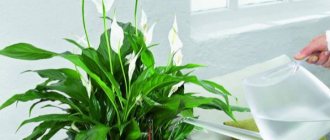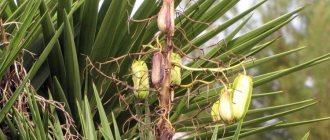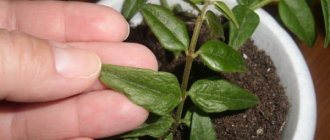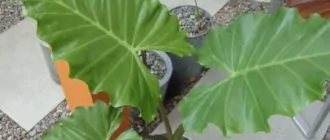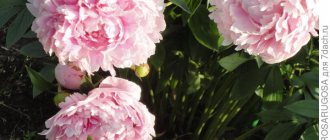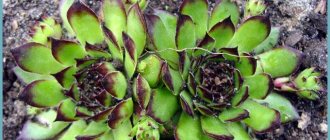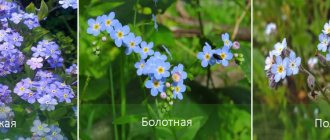Alocasia is a tropical perennial plant from the Araceae family. It grows wild in Southeast Asia (mainly Malaysia and Sri Lanka). In total, according to various estimates, there are about 50-70 species, but not all are suitable for growing at home.
One of the most successful varieties for indoor floriculture is Alocasia Dragon, a short but very beautiful plant. Below we will discuss the features of this species and the rules for caring for this rare tropical plant.
Detailed description and photo
Alocasia Dragon is a rather rare variety, but at the same time very spectacular. Its full name is Alocasia Dragon Scale, but in everyday life it is often called “dragon skin.” And indeed, a certain similarity is noticeable - the oval leathery leaves are dotted with veins pressed into the surface (they create a convex pattern on the underside of the plate).
This texture itself resembles dragon wings. And at the same time, the leaves have an unusual color - the plate has a lighter shade, from silver to pale green, and the veins stand out in a dark color.
Like other varieties of Alocasia, Dragonskin is a tuberous plant. Its leaves have succulent petioles and watery mouths-hydathodes. In nature, these plants love humidity, but excess moisture still needs to be removed, especially during the rainy season when the soil is oversaturated with it. This is what hydathodes are for.
It is interesting that the hydathodes act as a barometer - on the eve of rain, moisture is removed from them, and the plant seems to “cry”.
Alocasia micholitziana
This alocasia has a height of 40–50 cm and fits very well into any interior. The leaves of Alocasia Misholc also share many generic features with previous species. This is a 50-centimeter length, and a rich color, and a spear-shaped triangular shape. The leaf blades of the alocasia species shown in the photo have an interesting velvety green color and bright white veins. True, in this case there is no edging along the edge.
The petioles on which the leaves are attached are erect or slightly inclined, brown-green in color with reddish or brown stripes. Alocasia micholitziana is a native of the tropical regions of the Philippines, which explains the closeness of the described species.
How is it different from other types?
The main difference is the relatively small height with rather large and heavy leaves. The height of this plant in nature reaches 1 m, but at home it rarely grows above 50-60 cm.
Young foliage usually has a more even green color, but gradually lighter and darker areas appear on it, the veins become more pronounced, which gives the blades a leathery appearance.
Their petioles are not as long as other varieties. Over time, they can bend greatly under the weight of the leaves. This forms the recognizable silhouette of the flower.
The large leaves of Alocasia Dragon require quite a lot of space, so a windowsill for this plant is not the best option . Moreover, it does not tolerate drafts well. The ideal option would be a florarium, but the florist does not always have such an opportunity. Therefore, a small kitchen space is also suitable, provided that there is no air conditioning.
Types of alocasia with photos and names
Amazonian alocasia (Alocasia amazonica)
The height of the stem of such a plant can reach no more than 15 centimeters. Shield-shaped leaf plates grow on pinkish-green petioles, reaching a length of about 0.5 m. The notched, uneven plate, divided into lobes, is about 20 centimeters wide and up to 50 centimeters long. Dark green leaf plates are decorated with white veins, as well as stripes of the same color extending from them. When grown at home, the species does not bloom or bear fruit. However, if the bush does bloom, then it forms a low peduncle, at the top of which a flower-cob is formed, the length of which is about 10 centimeters, covered with a greenish-white blanket.
Alocasia sanderiana
This hybrid is most often cultivated in a greenhouse. The root system is a tuberous rhizome. The leaf blades have brownish-green petioles, the length of which can vary from 0.25 to 0.5 m. The green, elongated, arrow-shaped leaf blades are about 40 centimeters long and up to 15 centimeters wide. The plate is divided into lobes and is decorated with greenish veins and an edge with pale indentations.
Alocasia lowii
The height of a bush with a short trunk can reach about 100 cm. Long petioles are attached to the middle of the leaf blade. The foliage is green, and its veins can be the same color or white, while the underside is purple. The leaves come in both oval and arrow-shaped shapes. The species can be easily propagated by suckers formed on the roots.
Copper red alocasia (Alocasia cuprea)
The short stem is about 10 centimeters long and can be located underground. The length of the petiolate, ovate-heart-shaped leaf plates is about 30 centimeters, their front surface is green with a copper tint, and the back is bright purple. The leaves are slightly leathery to the touch. In indoor conditions, flowers and fruits do not form on the bush.
Alocasia cucullata
The diameter of the trunk of such a plant reaches approximately 50 mm, and its height can vary from 50 to 100 cm. The length of the petioles can also vary from 30 to 50 cm. The dark green glossy foliage is pointed at the top, and has a notch. The leaf width is about 80 cm, and the length is up to 100 cm. When grown at home, only large specimens bloom. The height of the peduncle reaches from 20 to 30 centimeters; at its top a small cob is formed, which is covered with a blanket slightly larger than its size (length about 15 centimeters).
Alocasia macrorrhizos
Or Indian alocasia (Alocasia indica). The length of the trunk reaches about two meters, long petioles (about 100 cm) extend from it, on which leaf plates grow. The heart-ovate leaves have a base divided into lobes, their length is about 100 cm and their width is slightly less. At home, flowers are formed very rarely. During flowering, a peduncle grows about 30 centimeters long. And on it a twenty-centimeter-long cob is formed, which is covered with a greenish-yellow blanket of the same size.
Alocasia odora
Herbaceous perennial plant. Petiolate, leathery to the touch leaf plates reach about 0.7 m in width and up to 1 m in length. The shape of young leaves is shield-shaped, and the adult plate is elongated and has a linear-ovate shape, it is divided at the base. At home it blooms extremely rarely; the flowers have a specific smell.
Alocasia houseplant. Care and maintenance at home. Part 3
Varieties
Dragon Scale is the common name of the species. However, depending on the shade of the leaves, two varieties are distinguished.
Alocasia Silver Dragon
It is distinguished by silvery leaves and dark veins.
Alocasia Pink Dragon
A rare variety with dark leaves, light veins and pink stems.
It is interesting that the cost of these varieties in different stores and garden centers can vary dramatically, but the “pink dragon” always costs more.
Alocasia flowering
If you properly care for the plant, alocasia can bloom. Its flower is unattractive and emits a pungent odor that can even cause a headache. At the same time, all the plant’s energy goes into flowering and ripening seeds, so the leaves begin to dry out and fall off.
Medicinal properties
In folk medicine, alocasia remedy is considered useful for tuberculosis and pathologies of the respiratory system, as well as for cancer. Wound healing and anti-inflammatory compresses are often made from the leaves.
Scientists are currently studying the medicinal potential of alocasia. So far, official medicine has not proven that it has healing properties. But given the fact that it contains vitamins, as well as flavonoids (for example, dihydroquercetin), its anti-inflammatory properties can be confirmed. In addition, it is possible that alkaloids like vinblastine contained in the leaves have an antitumor effect.
Alocasia fallax
The continental Asian species of Alocasia, which found its way into rooms and halls from the subtropics of the Himalayas, is considered by botanists to be a possible ancestor of the famous Alocasia odora. The height of this large plant can reach 2.5 meters. When a leaf is cut, a whitish milky sap is released. The petioles are dense, thick, up to one and a half meters long.
The leaf blade resembles many types of alocasia. It is round-oval, with a pointed tip. The length of an adult leaf can reach 130 centimeters. Peduncles are formed in the axils of the leaves, and 2–3 inflorescences can bloom simultaneously on a plant.
Bloom
In all types of alocasia, the inflorescences are not particularly decorative. The main decoration of the plant is the leaves. And in this variety they are especially good.
When and how?
Alocasia rarely blooms, but usually occurs between July and September.
The inflorescence is shaped like an ear. It has a pale white-pink hue.
The inflorescence consists of many small flowers. On one side it is covered with a rather dense sheet of cover.
What do the fruits look like?
After flowering and pollination, fruits are formed, which are oblong berries of a rich reddish-brown color with seeds inside.
Features of Alocasia
Alocasia is an evergreen plant that can have a clearly visible trunk, or it can also be stemless (depending on the species). The height of the bush is about 200 cm, but some species are not taller than 30–40 cm. The shape of the leathery, dense petiolate leaf plates is arrow-shaped or pointed-heart-shaped, and they can reach up to 100 centimeters in length (depending on the species). This plant can be grown as a single plant, and can also be used in flower arrangements. It is unpretentious in care, which is why it can often be found both in offices and apartments.
Where and at what price can I buy it?
You can buy an adult plant in a store or on the Internet (by advertisement). The first option is more preferable, since this gives the buyer more confidence that he is buying a healthy plant of the desired variety.
- The price of Silver Dragon is on average 1300-1400 rubles .
- Pink Dragon costs more - from 1500 rubles .
Where can I get planting material?
The plant's seeds are practically not sold, but seedlings can be purchased at a garden center or by advertisement. The price will be approximately the same - 250-300 rubles per seedling.
Alocasia reginula
The medium-sized and very attractive Alocasia reginula is well known to flower growers for its “Even Velvet” variety. The stems of this species are quite small and barely exceed 10 cm. They bear light cylindrical petioles with 30-centimeter ovoid or oval leaves. The leaf blade is dense, often convex, with a pointed tip and visible white veins. Sometimes the plants flower, producing a short, 10-centimeter peduncle with a cream-colored spadix hidden within a white or pinkish perianth.
Landing
In order for the plant to develop well, planting must be carried out according to all the rules.
Choosing a pot
The growing container is chosen taking into account the fact that Alocasia Dragon has an elongated rhizome.
Also, the pot must be very stable , since the leaves have a significant weight.
And of course, it should have drainage holes in the bottom.
What should the soil be like?
This plant prefers slightly acidic soils with a pH of 5.5-6.0. For it, you can choose special soils that are intended for representatives of the Aroid family.
In stores you can find soil for spathiphyllum or dieffenbachia - you can also buy it for alocasia.
Let's get down to business
When planting seeds, the algorithm of actions will be as follows:
- after collection, the seeds are planted in a light substrate and the container is covered with plastic film, making a kind of greenhouse;
- after germination, pick when a pair of true leaves appear and when the sprout reaches 10 cm;
- for about a year, until large leaves appear, the seedlings are kept in a mini-greenhouse to ensure the proper level of humidity;
- After large leaves appear, the plant is transplanted into a pot, at the bottom of which a drainage layer of expanded clay is placed.
When growing alocasia from cuttings, the algorithm will be generally similar, only first the cuttings are rooted in a nutrient substrate and kept in Kornevin’s solution.
Alocasia hypnos
Representatives of this species can be lithophytic or terrestrial herbaceous plants, having a dormant period and a height of more than a meter. The root system is tuberous and forms a large number of stolons and daughter tubers. The shoots grow vertically, covered with 3-6 leaves, which are supported on petioles about a meter long. The leaves have an elongated triangular configuration, about 80 cm long and about 65 cm wide, with a shiny surface and a rich green color. The veins are feathery and form a beautiful pattern on the leaves. It blooms with fused inflorescences in pairs, which develop together with the leaves. The flowers are attached to long light green peduncles about 90 cm long. The spathe is green. The plate of the bedspread is curved inward and has a pink-violet color. At the end of flowering, ovoid fruits are formed, one and a half centimeters long and 5 mm in circumference. At the initial stage of ripening, the fruits are green in color; when fully ripe, they become pink. Plants of this species can be seen in bamboo forests; they prefer to grow among fallen leaves at an altitude of up to 1000 meters above level. They grow with the help of stolons, which are formed in large numbers. In its wild habitat, the plant can grow to a height of over 4 meters.
Caring for a plant at home
In general, they care for the “dragon” in the same way as other types of alocasia, because it loves warmth and moisture in the same way.
Temperature
Temperature is very important for this plant. Even in winter, the room must be at least +16°C, otherwise the alocasia will begin to dry out after some time.
Lighting
You need to take care of intense but diffuse lighting.
Attention! The flower should not be left in bright sun, as this may cause the leaves to burn.
Watering
Alocasia is a plant native to the humid tropics, so at home it also requires high air humidity. And the soil must always be moist. But this effect is achieved not due to the abundance of watering, but solely due to its frequency. Only in winter, when the dormant period begins, can the frequency of watering be reduced.
In addition, it is advisable to periodically spray the leaves of alocasia . Soft water is suitable for this purpose, which is pre-heated slightly so that it is slightly warmer than room temperature.
Top dressing
For alocasia, it is recommended to use dry complex fertilizer. It is laid in a layer at the bottom of the pot when planting the plant. If this is not possible, then you need to feed the plant with liquid fertilizer intended for deciduous indoor flowers. From spring to mid-autumn this is done every two weeks. In winter, fertilizing is not carried out.
Trimming
Cleaning pruning is carried out as necessary to get rid of dried leaves.
Transfer
An adult plant is replanted no more than once every three years, a young plant - as it grows.
Care during the flowering period
Experienced gardeners recommend removing inflorescences , since they take resources from the leaves - the main decoration of alocasia. The place where the flower is cut is treated with crushed charcoal for disinfection.
What to do if the buds don't appear?
There is no need to make any effort for the plant to bloom. The main thing is to take care of the leaves.
Reproduction
This plant can be propagated by both seeds and cuttings, division of rhizomes and nodules. Propagation by cuttings is considered the easiest way.
Growing Alocasia
Alocasia
Soil . In nature, alocasia grows in rich, moist soils. For planting, you can use special ready-made soil for aroid plants or universal soil for indoor plants. The soil mixture itself is made up of the following components: leaf soil: humus: peat: sand (1: 1: 1: 0.5). You can add pieces of charcoal and chopped sphagnum to the mixture. The basic requirements for the substrate are that it must be porous, with a slightly acidic environment (pH 5.0-6.0). For alocasia, select tall pots and provide them with good drainage.
Transplantation is carried out annually in the spring into a pot 2-3 cm wider in diameter. Fast-growing specimens are replanted twice a year, and adult specimens - every 2-3 years. Transplantation is best done by transshipment without destroying the root ball.
There is no need to enlarge the pot too much - alocasia loves tight spaces, and in addition, in a large pot the risk of the substrate becoming waterlogged will increase.
- Soils and soil mixtures for indoor plants
- Repotting indoor plants
Temperature . Alocasia is a tropical heat-loving plant that is afraid of air conditioners, cold drafts and freezing. In summer, the comfortable temperature for the plant lies within +22... +26°C, in winter - +18... +22°C. The maximum permissible temperature at which it is already difficult to maintain the plant is +29°C. And the minimum temperature for alocasia is +16°C. A lower level causes the leaves to droop and can trigger a dormant period.
Lighting . Alocasia prefers bright, diffused light. It is optimal to place the plant on windows facing east and west. In the south, it is necessary to shade them from direct sunlight in the spring and summer, otherwise the leaves may receive serious burns.
The most tolerant of morning direct sunlight are zebra-striped and large-rhizome alocasia.
Alocasia with green foliage can withstand some shading, while variegated forms can only appear in all their glory with sufficient lighting.
Amazonian Alocasia (Alocasia x amazonica) Polly
Watering . The plant is very moisture-loving and requires abundant watering in spring and summer. It is carried out in several stages so that the soil is evenly saturated with moisture until the water comes out into the pan. Excess water is drained from the pan. Between waterings, allow the top layer of soil to dry to a depth of approximately 5 cm. The soil should always be moist, but not dry or damp.
In winter, watering is reduced somewhat, allowing the plant to stand for a day with the top layer of soil dry.
Try to keep the soil evenly moist. It is important not to allow the soil to dry out or become waterlogged, which can have a detrimental effect on the plant. Alocasia reacts very quickly to a lack or excess of moisture.
For more details, see the article Rules for watering indoor plants.
Air humidity . Alocasia prefers high humidity. The pot with the plant is placed on a tray with wet expanded clay. Make sure the plant is standing on expanded clay and not in water. The plant is sprayed with non-cold, settled water, but in winter this is done carefully. Leaves in spring and summer are wiped from dust with a damp cloth.
Feeding . The plant is fed every 2 weeks with a half dose of fertilizer for ornamental foliage plants from the end of March to September. Excess fertilizer leads to the accumulation of salts in the soil and burning of leaves. In winter, subcortical treatments are canceled. It is best to choose organic-mineral fertilizers, or alternate mineral with organic ones.
Read more in the article Feeding indoor plants.
Rest period . In winter (from October to March), a relative period of rest begins, caused by reduced light and air humidity. The need for moisture is reduced, so water the plant moderately, do not feed it and maintain the recommended lower temperature (see above). Don't worry in winter if the plant continues to grow, that is, new leaves appear.
Some types of alocasia have a true dormant period; their foliage dies off for the winter. But species grown indoors are usually not one of them. However, some alocasias enter a dormant state if there is a combination of short days and low temperatures. This can be avoided by moving the plant to a warmer location as winter approaches. Next, you need to follow the usual instructions for caring for the plant. The only difference is that watering is limited and the plant is not fed until new leaves appear in the spring.
Alocasia reginula Black Velvet
Bloom . In indoor conditions, flowering is extremely rare. Your best chance of seeing a modest spadix with a small spathe is if you grow Alocasia "Black Velvet", which blooms most readily. The rest can bloom in greenhouses and warm tropical winter gardens, especially when grown not in a pot, but in the ground, as well as in the presence of artificial supplementary lighting.
However, there is no need to be upset about this, because... Alocasias are most valued for their beautiful foliage, which, by the way, often hides the inflorescences. And they are not very decorative; the leaves are much more beautiful. So the focus should be on maintaining healthy foliage.
In greenhouses, scarlet berries are sometimes produced, but not all alocasias.
Poisonousness . Alocasia contains toxic transparent milky sap, which can cause irritation of the skin and mucous membranes, and if ingested, vomiting. The tubers of different species have varying degrees of toxicity, some contain a high dose of calcium oxalate, just like the leaves of most alocasia. In addition, some types contain hydrocyanic acid. Plants should be placed out of the reach of children and pets. Transplantation and division work must be done with gloves. Hands must be washed thoroughly with soap, even after simply wiping the leaves.
Pests and diseases . Alocasia is affected by mealybugs, scale insects, aphids, and spider mites. For prevention, you can spray the plant with warm water and insecticidal soap every few weeks.
Read more in the article Pests of indoor plants and measures to combat them.
When Alocasia is over-watered, or when the leaves are constantly left wet, various fungal diseases develop, such as stem and root rot, and leaf spot. These diseases usually appear as dark brown or black spots on the leaves surrounded by a yellowish edge. The best way to prevent disease is to avoid overwatering, keep the leaves dry and allow good air circulation around the plant. If the plant does become sick, quickly remove damaged and drooping leaves, isolate from other plants and treat with a fungicide.
Diseases and pests
It happens that alocasia leaves stop growing and turn yellow, or white fluff appears at the base of the petioles - all these are symptoms of various diseases or pest damage.
For example:
- Yellowing of the leaves and the formation of a kind of cobweb on their underside is a spider mite.
- A white sticky coating at the base of the cutting is a mealybug infestation.
- Rotting of cuttings may indicate a fungal infection.
- Sometimes aphids appear on alocasia leaves. And if the room is warm, then the reproduction of such pests is especially active.
Important! Action must be taken urgently, otherwise the plant will die.
Reproduction of alocasia
The plant can be propagated by cuttings, dividing the bush or planting seeds.
A sand-peat mixture is suitable for planting seeds. This should be done in the spring, immediately after collecting the seeds, as they quickly lose their ability to germinate. The seeds are planted to a depth of no more than 1 cm. After which the soil is moistened and the pot is covered with film. You need to keep it in a warm place. Usually the first shoots appear 3 weeks after planting.
As soon as several leaves appear on the seedlings, they should be planted in small-diameter pots. Alocasia should be replanted for the first time only when the roots completely entwine the ground in the pot. Typically, large leaves on the plant begin to appear after 1 year.
Using the cutting method, many varietal characteristics of a plant can be preserved. To strengthen the cuttings, in the first half of spring, a leaf with part of the stem is cut off. This place is treated with charcoal dust, and the cutting itself is kept a little in the root and placed in a sand-peat mixture. If everything is done correctly, then after a few weeks you will have a new young plant that can immediately produce large leaves.
The third way to propagate alocasia is by dividing the bush. This is usually done in the spring when replanting the plant. First, the roots are completely cleared of the soil and the bush is divided into several parts with a sharp knife. In this case, it is important that in each of the separated parts there should be a growing point or a leaf rosette. After treating the cut with activated carbon, the plant can be planted in the ground.
The plant needs to be replanted several times a year. To do this, select a stable pot with drainage placed at the bottom. The soil should be nutritious and loose. A mixture of peat, leaf and coniferous soil with the addition of river sand would be ideal.
Treatment/control methods
Control methods depend on what exactly the grower is facing.
- Spider mites are mechanically removed from the leaves using a brush with stiff bristles, which is pre-moistened in a weak soap solution, then thoroughly washed with water.
- Mealybugs are removed from the cuttings with a cotton swab soaked in an alcohol solution, then the affected area is washed with water.
- When infested with aphids, the plant is treated with an appropriate chemical, for example Fufanon.
In case of severe mite infestation, it makes sense to use special chemistry - for example, Decis.
Alocasia lauterbachiana
The type of alocasia shown in the photo is characterized by highly elongated, notched leaves held on variegated, erect petioles. It is interesting that until recently, Alocasia lauterbachiana, which attracted the attention of gardeners, was classified by botanists as a different genus of plants. And having joined the large community of alocasia, it immediately became a popular indoor plant.
The plant, 80 to 130 cm high, has long dark green leaves, with a distinct burgundy tint on the back side. Purple and petioles of leaves, as well as peduncles holding large single inflorescences.
Prevention of various problems
Over time, the leaves inevitably turn yellow, but if green veins remain on them, and then they gradually dry out, this is a natural aging process. You just need to cut off such leaves. But if only the upper leaves turn yellow and dry out, this means that the air is too dry for the plant; you need to spray the alocasia with warm water more often.
If young leaves practically do not appear or grow small, this indicates that the plant requires feeding.
Alocasia Dragon is a beautiful indoor plant that will fit perfectly into any interior. The main thing is to follow all the rules for caring for it.
Plant diseases
If the rules of caring for the plant are not followed, it may become ill. For example, if there is not enough light for it, it may lose its color. Dry air is the cause of drying out. Too cold? The leaves will become covered with dark spots. Overwatering can lead to root rot. Therefore, do not underestimate the importance of plant conditions. Otherwise, a situation will not be far off when your Alocasia has dropped all its leaves. And what to do in such a situation if your flower has lost its leaves? It is better not to let this happen and immediately provide the plant with proper care.
In addition to the above diseases, the plant can be affected by pests. If you find them, wash the Alocasia with soapy water, and then spray it with a special solution against pests. If you find a pest on a plant, do not hesitate! Be sure to apply insecticides and remove them from the plant.
Alocasia - description of the plant
Alocasia (Alocasia) from the Araceae has received the eloquent nicknames “elephant”, “elephant ears” and “African mask” for the size and shape of its leaves.
Alocasias in rooms rarely exceed 1 m in height and almost always retain their leaves for the winter. They are evergreen large-leaved stars with a thick, short, upright stem and a stolon-like or tuberous rhizome. Usually on one plant with good maintenance you can admire 6-8 leaves. The plant produces about one leaf per month.
The leaves are very large, lobed, thyroid-shaped, densely leathery, from 20-30 cm to 80 cm in length, on powerful petioles 30-100 cm high with long sheaths. The unclear shape and color of young leaves change to arrow- or heart-shaped with very large teeth along the edges - in adults. The strong gloss of the leaves emphasizes the wavy curves of the surface.
Alocasia sanderiana.
In some species the color is light and monochromatic, in others it is almost black with thick contrasting veins. The pattern of the veins is special: the petiole is divided into three central veins (the main and lateral segments), and the secondary veins create a feather pattern, merging into the marginal border. The leaves have hydathodes - water stomata that secrete drops of water when waterlogged.
Alocasia rarely blooms in rooms. The inflorescences are hidden in the mass of leaves, not exceeding the petioles in height. The greenish-colored cobs are hidden by a blanket with a slight constriction. Half-balls of red berries are an even rarer sight.
Alocasia, especially the rhizomes, must be handled very carefully. Toxic substances can cause serious irritation and poisoning.
Growing problems: table of signs and remedies
Problems may arise when growing this tropical flower, but most often they appear if the alocasia has not been provided with proper care.
| Problem | Reasons for appearance | Ways to correct the situation |
| Leaf wilt |
| Replant the plant and provide it with proper watering |
| Drying of the edges of the tips of the leaves | Dry indoor air | Use a spray bottle to humidify the air more often |
| Growth slowdown | Nitrogen deficiency | Feed the plant with nitrogen-containing fertilizer. Dosage – 1 g per 1 liter of water |
| Yellowing of leaves |
| Move the pot with alocasia to a room protected from drafts. Water the plant only with boiled water |
| The appearance of dark spots on the leaves |
| Shade the flower and move the pot to a warm room |
| Dropping leaves |
| The peduncle must be removed and the plant fed with complex fertilizer |
| Fading of sheet plates | Insufficient lighting | Provide alocasia with additional artificial lighting |
| The appearance of water drops on the leaves | Excess moisture | Drain the water from the pan and let the soil surface dry |
Growing conditions for indoor alocasia
It is easier to satisfy the tropical needs of alocasia in greenhouses or flower displays. Plants in living rooms are especially affected from autumn to spring. For them, you need to monitor the heat and compensate for the lighting.
Lighting and placement
Alocasias are lovers of stable and constant soft lighting, without direct sun. In summer, it is better to place them in soft partial shade, on a northern window sill or near brighter windows, in winter - on the brightest window sill to compensate for the reduction in daylight hours. Green-leaved plants are more shade-tolerant, while variegated ones are quite light-loving.
Alocasia Polly: care and features
For normal development, flowers require proper care.
Let's consider how to care for a plant? Much attention should be paid to watering, lighting, fertilization, temperature conditions
This flower is quite demanding of natural light.
Watering
It is best to place a pot of Alocasia on a tray already covered with moistened pebbles or expanded clay. The bottom of the pot should not come into contact with water, this will cause rotting of the roots. Watering is carried out the next day after the top layer of soil dries. This rule applies to summer, winter and spring soil moisture. The number of waterings of the flower will depend on the temperature in the room, light intensity and air humidity.
Soil for Alocasia and bait
For the proper development of this flower, moisture-intensive and well-aerated soil with an acidity pH of 5.6 is required. A nutrient substrate at home can be made from the following components:
- one part peat;
- 0.5 parts sand;
- one part of the land, which is taken from under coniferous trees;
- one part of leaf soil.
Bait is produced at least twice a month. Flowers require the most nutrients during active growth (summer). The bait for this plant must contain high concentrations of nitrogen.
Reproduction
There are several ways to propagate Alocasia.
The main option for obtaining new flowers is to use tubers. Small formations - babies, can be seen on the roots of an adult plant
They are carefully cut off from the rhizome and placed in nutritious soil. At first, the baby can be transplanted into a small disposable cup, but when the plant develops at least one leaf, it needs to be moved to a spacious pot. Another method of propagation is to use the leaves of the plant.
To perform the procedure, you need to take the bottom leaf with a piece of the cutting. After about a few hours, the bottom of the petiole needs to be trimmed and treated with a growth activator. Then the leaf is placed in moistened special soil for rooting. When sprouting, the future flower needs to be provided with sufficient moisture. The plant is protected from drying out of the soil and drafts; it is not recommended to allow the soil to become waterlogged. The seed method of propagating Alocasia is the most labor-intensive. It’s just that this plant does not often throw out inflorescences, which is why the seeds of this crop are in short supply. The seeds appear in the middle of red or yellow inflorescences; their moisture can remain until the moisture evaporates from the shell. Therefore, the grains must be sown immediately after harvesting in prepared soil. The soil for seedlings must consist of humus, sand and peat. The seeds are placed on the surface of the ground, moistened with a flower sprayer and covered with transparent glass or plastic film. Taking into account the development of the flower, it is transplanted into larger pots.
Alocasia: plant transplantation
The Alocasia transplant procedure consists of the following steps:
Choosing a flowerpot for a flower. It is advisable to choose a pot that is not very wide and high, since the root system of this crop is large in length. Attention should be paid to the fact that the diameter of the new pot must be several centimeters larger than the old one. It is not recommended to replant the flower in large pots; due to prolonged drying of the soil, it may sour. At a further stage of work, several holes are made in the pot for drainage (when they are not provided by the manufacturer). The easiest way to make holes is with a red-hot nail. Making or buying nutritious soil for Alocasia
The main requirements for soil are good moisture holding capacity and aeration. We take the flower out of the old container, carefully shake the roots, trim off dead and rotten roots. We place expanded clay or other material for drainage at the bottom of the new pot and replant the plant. We fill the gaps that appear with new soil. The first watering of the plant is done after the soil has dried to a third of the container.
Attention: in order to prevent stressful situations after transplantation, the plant must be sprayed with epin. These operations must be performed with rubber gloves, since the juice of the described flower is poisonous


